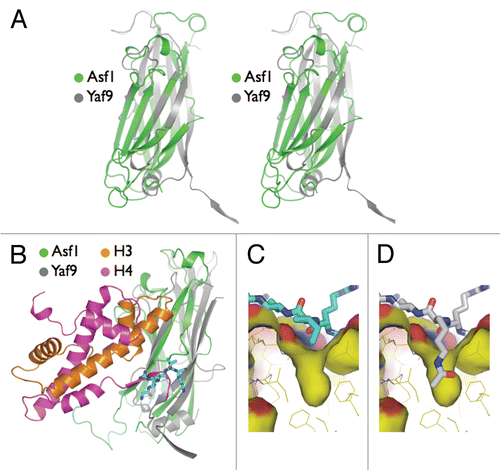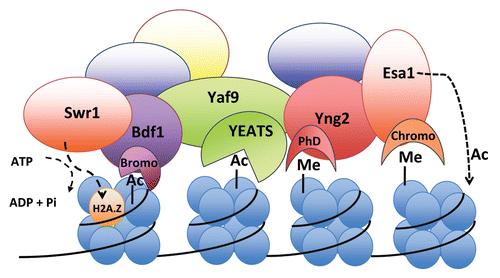Figures & data
Figure 1 Interaction of the Yaf9 YEATS domain hydrophobic groove with its potential target. (A) Structural comparison of the Yaf9 YEATS domain and Asf1 core. Stereo superposition of the Yaf9 YEATS domain on Asf1. The ribbon diagram is colored gray for Yaf9 and green for Asf1. (B) Docking of the Asf1/histone H3–H4 complex onto Yaf9. Note that the N-terminal tail/hydrophobic groove interaction formed between symmetry-related Yaf9 protomers (cyan sticks) spatially and directionally overlaps with the interaction seen between the C-terminal tail of histone H4 (magenta ribbon) and Asf1. In both instances, the peptide from the binding partner docks into an inter-sheet groove and pairs by the last (“h”) strand of the Ig fold. (C) Close up of the Yaf9 YEATS domain hydrophobic groove (surface) and its interaction with the N-terminal segment of adjoining protomer (cyan sticks). An isoleucine in the peptide sits over a deep hole in the floor of the groove. (D) The hole in the hydrophobic groove (surface) of the Yaf9 YEATS domain is sufficiently wide and deep to accommodate a modeled acetyl-lysine residue (white sticks). The modified lysine was modeled using the preferred rotamer library available in PYMOL.Citation41

Figure 2 Model highlighting the SWR1-C and NuA4 complexes with their respective “reader” and “writer” subunits containing signature domains that bind to acetyl- or methyl-groups on histones. The SWR1-C subunit Bdf1 has bromodomains that bind to acetylated histones and NuA4 subunits Yng2 and Esa1 have a PhD finger and chromodomain, respectively, that bind to methylated histones.Citation37 Note that the YEATS domain of Yaf9 binding to acetyl groups on histones is speculative in nature and requires further experiments to provide support. Furthermore, it is possible that the subunits bind to the same nucleosome rather than multiple nucleosomes as shown.
